Clouded Judgement 3.8.24 - 2024 Guides
Every week I’ll provide updates on the latest trends in cloud software companies. Follow along to stay up to date!
2024 Guides - Are they Conservative?
So far we’ve got a number of full year 2024 guides. Overall, companies are not guiding above current consensus (median guide is 0.2% below consensus). Is this just companies guiding conservatively, to set up the year for beat and raises? There’s been a lot of dislocation in the world, and after going through the last few years I can see how companies would want to “set a low bar” for the full year.
MongoDB is fresh on my mind as they reported earnings yesterday. Despite beating Q4 by 6%, they guided the full year 5% below consensus estimates (and also guided Q1 ‘24 2% below consensus estimates). The full year guide assumes 14% growth for this upcoming year after they grew 31% in 2023. They did call out a couple one time benefits they saw in 2023 they don’t expect to see in 2024. One of these was recognizing $40m of revenue in 2023 from unused Atlas commits, and a new sales comp structure that moves incentives away from up front commits (and thus means they expect to recognize $0m in revenue this upcoming year from up front commits). The other one time benefit from 2023 was ~$40m of multi-year license deals. They don’t expect that aggregate $80m of revenue from 2023 to repeat in 2024. IF you factor in that $80m (ie give them credit this year which was probably baked into consensus), then the full year guide was only 1% below consensus.
So was the guide for this year conservative? A year ago, they guided 2023 growth to 16%. They ended up actually growing 31% (and if you remove that $80m of revenue mentioned above then growth was still 25%, but I’m not quite sure it makes sense to remove that $80m since the comp structure at the time was more based around committed credits). Either way - they ended up performing much better than their initial guide, and ultimately their stock was one of the top preforming software companies in 2023 (they were up >100%). I’m not trying to imply the reason the stock performed so well was they gave themselves a low bar and then exceeded it. There was way more to it than that. However, in this environment (ie if macro / rates don’t turn into a headwind), normally the simple analysis on what drives a stock is “are the estimates going up or down?”
Q4 earnings (what we’re going through right now) are generally the first period where we get full year guides. Companies that come in meaningfully lower than consensus (Snowflake, Palo Alto Networks, Mongo, etc) generally see big hits to their stock as forward estimates are coming down. Companies that come in ahead of consensus (Confluent, Samsara, etc) generally see their stocks go up as numbers are going up. Again, it’s a lot more nuanced than that and the setup leading into the quarterly report matters a lot.
I do think that identifying stocks who are most likely to outperform their full year guide coming out of Q4 earnings will provide the best setup for 2024 performance.
Quarterly Reports Summary
Top 10 EV / NTM Revenue Multiples
Top 10 Weekly Share Price Movement
Update on Multiples
SaaS businesses are generally valued on a multiple of their revenue - in most cases the projected revenue for the next 12 months. Revenue multiples are a shorthand valuation framework. Given most software companies are not profitable, or not generating meaningful FCF, it’s the only metric to compare the entire industry against. Even a DCF is riddled with long term assumptions. The promise of SaaS is that growth in the early years leads to profits in the mature years. Multiples shown below are calculated by taking the Enterprise Value (market cap + debt - cash) / NTM revenue.
Overall Stats:
Overall Median: 6.2x
Top 5 Median: 19.4x
10Y: 4.1%
Bucketed by Growth. In the buckets below I consider high growth >30% projected NTM growth, mid growth 15%-30% and low growth <15%
High Growth Median: 13.0x
Mid Growth Median: 9.5x
Low Growth Median: 4.6x
EV / NTM Rev / NTM Growth
The below chart shows the EV / NTM revenue multiple divided by NTM consensus growth expectations. So a company trading at 20x NTM revenue that is projected to grow 100% would be trading at 0.2x. The goal of this graph is to show how relatively cheap / expensive each stock is relative to their growth expectations
EV / NTM FCF
The line chart shows the median of all companies with a FCF multiple >0x and <100x. I created this subset to show companies where FCF is a relevant valuation metric.
Companies with negative NTM FCF are not listed on the chart
Scatter Plot of EV / NTM Rev Multiple vs NTM Rev Growth
How correlated is growth to valuation multiple?
Operating Metrics
Median NTM growth rate: 13%
Median LTM growth rate: 17%
Median Gross Margin: 75%
Median Operating Margin (12%)
Median FCF Margin: 10%
Median Net Retention: 110%
Median CAC Payback: 37 months
Median S&M % Revenue: 42%
Median R&D % Revenue: 25%
Median G&A % Revenue: 16%
Comps Output
Rule of 40 shows rev growth + FCF margin (both LTM and NTM for growth + margins). FCF calculated as Cash Flow from Operations - Capital Expenditures
GM Adjusted Payback is calculated as: (Previous Q S&M) / (Net New ARR in Q x Gross Margin) x 12 . It shows the number of months it takes for a SaaS business to payback their fully burdened CAC on a gross profit basis. Most public companies don’t report net new ARR, so I’m taking an implied ARR metric (quarterly subscription revenue x 4). Net new ARR is simply the ARR of the current quarter, minus the ARR of the previous quarter. Companies that do not disclose subscription rev have been left out of the analysis and are listed as NA.
Sources used in this post include Bloomberg, Pitchbook and company filings
The information presented in this newsletter is the opinion of the author and does not necessarily reflect the view of any other person or entity, including Altimeter Capital Management, LP ("Altimeter"). The information provided is believed to be from reliable sources but no liability is accepted for any inaccuracies. This is for information purposes and should not be construed as an investment recommendation. Past performance is no guarantee of future performance. Altimeter is an investment adviser registered with the U.S. Securities and Exchange Commission. Registration does not imply a certain level of skill or training.
This post and the information presented are intended for informational purposes only. The views expressed herein are the author’s alone and do not constitute an offer to sell, or a recommendation to purchase, or a solicitation of an offer to buy, any security, nor a recommendation for any investment product or service. While certain information contained herein has been obtained from sources believed to be reliable, neither the author nor any of his employers or their affiliates have independently verified this information, and its accuracy and completeness cannot be guaranteed. Accordingly, no representation or warranty, express or implied, is made as to, and no reliance should be placed on, the fairness, accuracy, timeliness or completeness of this information. The author and all employers and their affiliated persons assume no liability for this information and no obligation to update the information or analysis contained herein in the future.






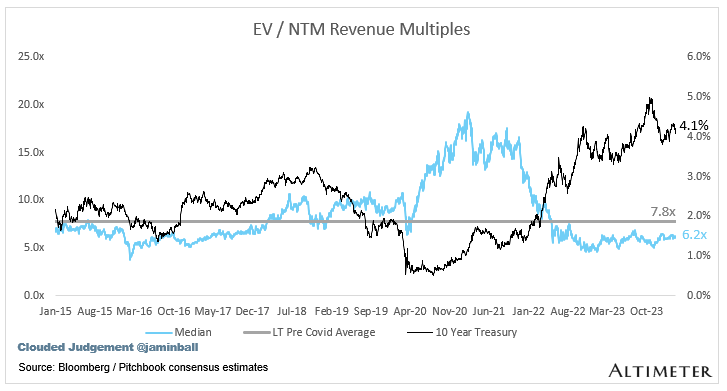


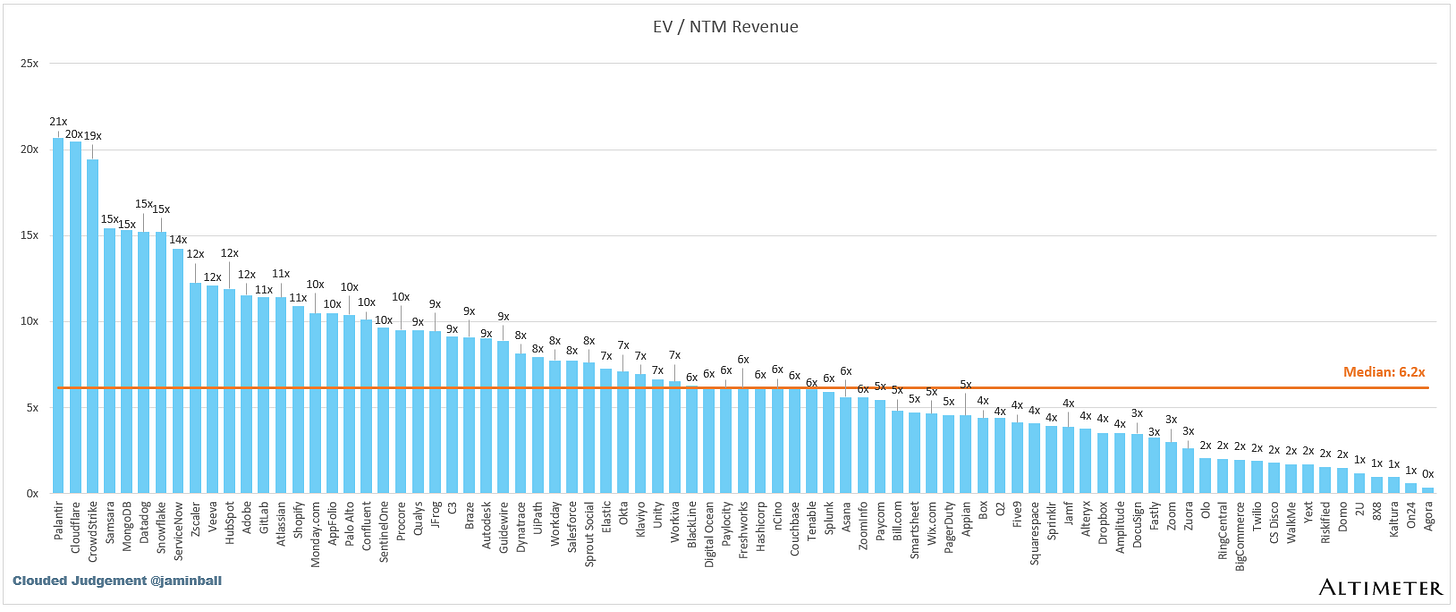
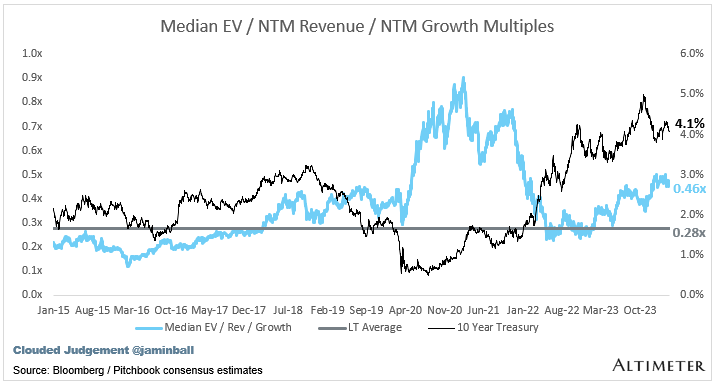

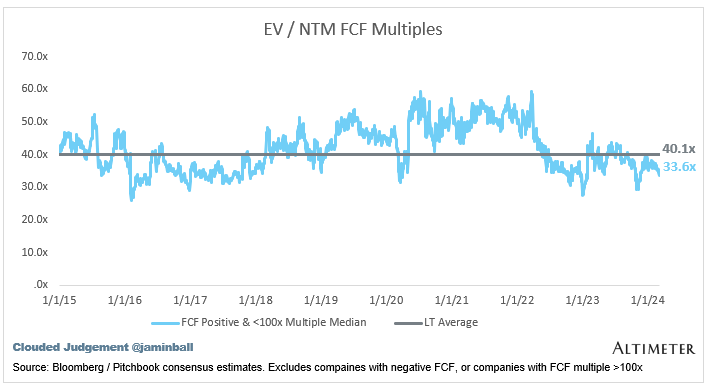
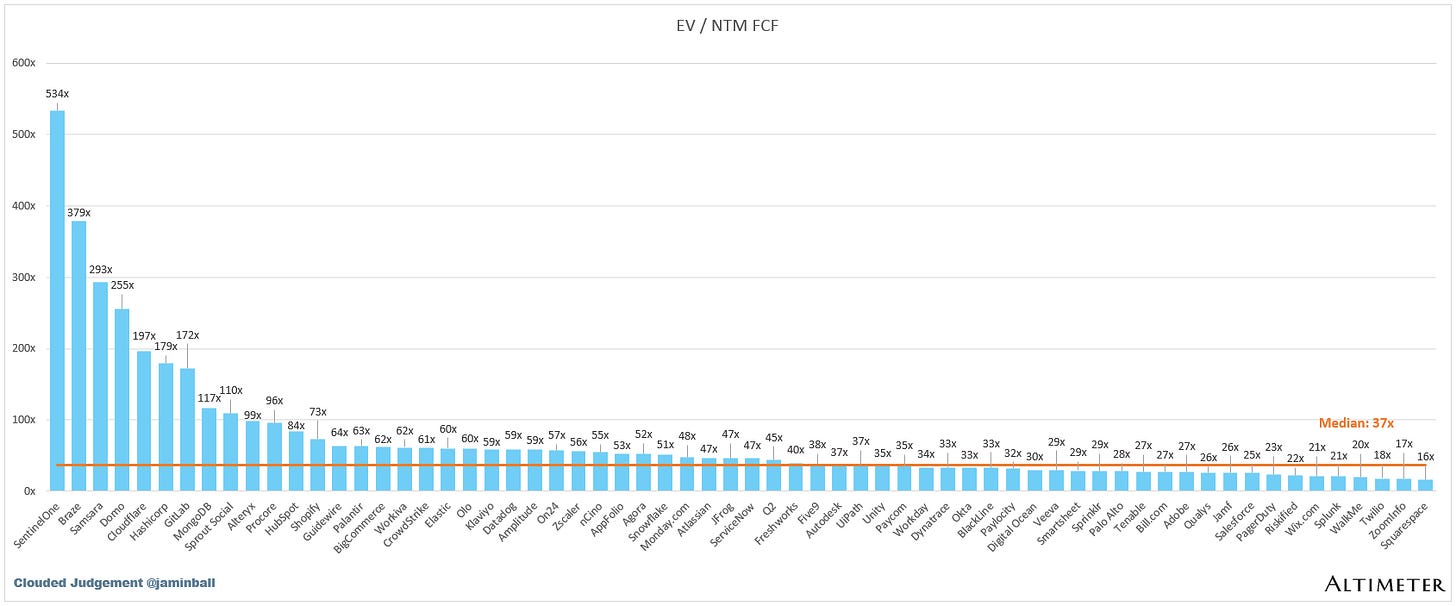
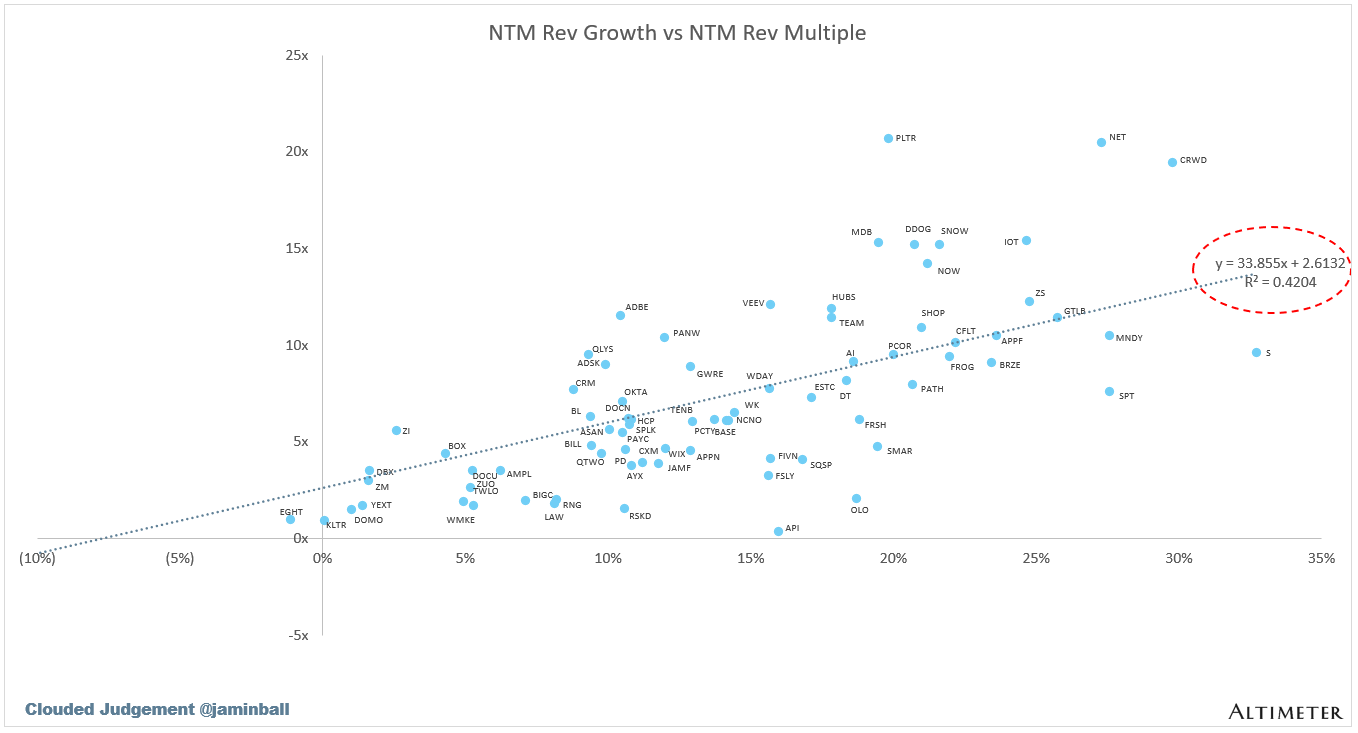



Interesting - when looking at the graph of EV / NTM revenue multiples vs the 10Y yield, one would think there is room for multiple expansion upwards given current median is below historical average and given the seemingly inverse correlation with the 10Y, one would expect re-rate upwards if in fact the 10Y begins to fall after the fed starts to lower rates. However, the below chart with EV / NTM rev / NTM growth clouds that picture to a degree given the current mult / growth ratio is not only above historical averages, but actually somewhat in-line with the movement of the 10Y.
I find it difficult to trust mgmt teams that play the under promise and over deliver game. I also did not like it when my employees or managers did this in my corporate career. I think it does a disservice to shareholders and comes to bite the stock later on. Give us your best guesstimate as of now and the report the results after three months good or bad and reasons behind the performance. That is the way good mgmt operates. Cheers Jamin!